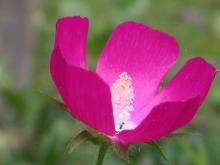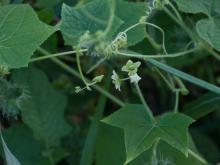Wildflowers, Grasses and Other Nonwoody Plants
Media

Species Types
Scientific Name
Najas spp.
Description
Naiads are slender, narrow-leaved plants that grow completely under water and are rooted to the bottom. They never have broad, floating leaves or conspicuous flowers or seed heads.
Media

Species Types
Scientific Name
Ceratophyllum demersum
Description
Coontail, a common submerged aquatic plant, got its name from the crowded upper leaves, which make the stem tip appear bushy like the tail of a raccoon.
Media

Species Types
Scientific Name
Callirhoe involucrata
Description
Purple poppy mallow, a native Missouri prairie wildflower, is a favorite of wildflower gardeners. It’s easy to care for and a showy choice for formal or informal landscaping.
Media

Species Types
Scientific Name
Sicyos angulatus
Description
Bur cucumber is a nonwoody, native, annual vine common in low, moist soils. It can spread across an area 20 feet wide, covering the ground and nearby shrubs. Note its lobed, gourd-family leaves, curly green tendrils, clusters of prickly, green, oval fruits, and 5-lobed, cream-colored flowers.
Media

Species Types
Scientific Name
Glechoma hederacea
Description
Ground ivy, or creeping Charlie, is a creeping, nonwoody plant that often forms loose mats. A native of Eurasia, this member of the mint family has been introduced nearly throughout the United States. It is considered a lawn and garden weed.
See Also
About Wildflowers, Grasses and Other Nonwoody Plants in Missouri
A very simple way of thinking about the green world is to divide the vascular plants into two groups: woody and nonwoody (or herbaceous). But this is an artificial division; many plant families include some species that are woody and some that are not. The diversity of nonwoody vascular plants is staggering! Think of all the ferns, grasses, sedges, lilies, peas, sunflowers, nightshades, milkweeds, mustards, mints, and mallows — weeds and wildflowers — and many more!





















